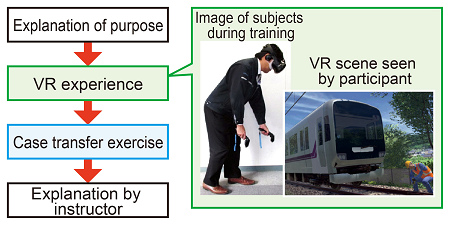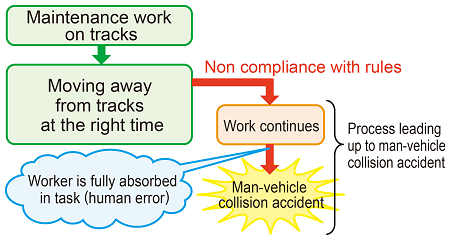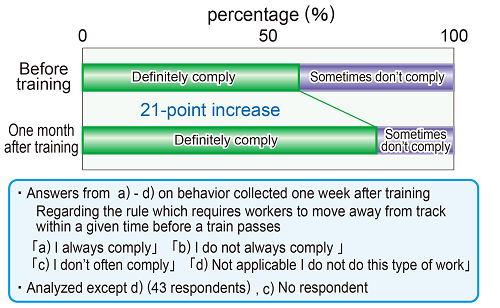9. VR-based training to prevent man-vehicle collision accidents
There is a need to educate frontline railway personnel about the risks of violating rules, however, there has been a lack of clarity about exactly what risks should be highlighted during training.
After analyzing past cases involving track maintenance or work on electrical installations, and conducting opinion surveys among on-site railway personnel, it became clear that training was necessary in particular to understand the“processes leading up to accidents”in order to promote more rigorous rule keeping.
Consequently, a“VR experience-based training method”was developed to provide training on better understanding the processes leading to man-vehicle collision accidents (Fig. 1).
The training method comprises two types of module, the “Virtual reality experience” and “Case transfer.” The“VR experience”module is a role play exercise where the subject is given the role of the person in charge of a worksite. The subject is immersed in a VR scenario, where they can walk around a simulated space and participate in track maintenance work. One of the scenarios used raises awareness about the process that leads to a man-vehicle collision accident due to lack of attention to approaching trains when fully absorbed in a task: through the exercise, the subject is able to understand the importance of moving away from a track at the right time (Fig.2). The“Case transfer”part of the training, uses past cases as a reference. Subjects take part in a group discussion, and reflect on how the process leading to a man-vehicle collision accident could apply to their own workplace, and examine what tangible countermeasures could be implemented.
The“VR training method to prevent man-vehicle collision accidents”was trialed with a group of on-site personnel.
The training improved their understanding about how man-vehicle collisions occur, and compared to before the training, the number of respondents who said they would fully comply with rules for moving away from tracks at the right time, rose by 21 points (Fig. 3).
The satisfaction level among participants was particularly high for the VR experience, with 96% of respondents agreeing that it was“true to reality.”
It is hoped that implementing this training will increase level of compliance with rules that can prevent man-vehicle collision accidents.
Other Contents
- 1. Real-time hazard mapping system for localized heavy rainfall-induced disasters
- 2. Earthing system testing device for lightning protection in power supply installations
- 3. Vertical damper to suppress decrease in wheel load on container wagon bogies
- 4. Seismic reinforcement methods for improving anti-catastrophe performance of railway viaducts
- 5. Support System for verifying evacuation safety in case of station fire
- 6. Early railway line tsunami inundation forecasting method
- 7. System for determining the stability of slopes during snowmelt season
- 8. Measures for reducing damage to overhead contact line system due to bridge oscillations caused by passing trains
- 9. VR-based training to prevent man-vehicle collision accidents
- 10. Method for evaluating train running safety during earthquakes considering non-linear behaviour of structures
- 11. Critical wind speed of overturning based on actual measured lateral vibration acceleration
- 1. Real-time hazard mapping system for localized heavy rainfall-induced disasters
- 2. Earthing system testing device for lightning protection in power supply installations
- 3. Vertical damper to suppress decrease in wheel load on container wagon bogies
- 4. Seismic reinforcement methods for improving anti-catastrophe performance of railway viaducts
- 5. Support System for verifying evacuation safety in case of station fire
- 6. Early railway line tsunami inundation forecasting method
- 7. System for determining the stability of slopes during snowmelt season
- 8. Measures for reducing damage to overhead contact line system due to bridge oscillations caused by passing trains
- 9. VR-based training to prevent man-vehicle collision accidents
- 10. Method for evaluating train running safety during earthquakes considering non-linear behaviour of structures
- 11. Critical wind speed of overturning based on actual measured lateral vibration acceleration



